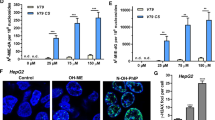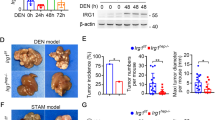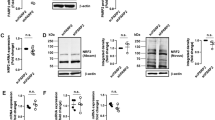Abstract
Anti-oxidant response element (ARE) and nuclear factors including Nrf2 and small Maf (MafG and MafK) proteins are known to regulate expression and induction of detoxifying enzyme genes including quinone oxidoreductase1 (NQO1). Nrf2 upregulates and small Maf proteins lacking the transcriptional activation domain down regulates ARE-mediated expression and induction. In this report, we have investigated the role of c-Maf (large Maf) containing the transcriptional activation domain in the regulation of ARE-mediated genes expression. The overexpression of c-Maf in human hepatoblastoma (Hep-G2) cells led to the repression of ARE-mediated NQO1 and GST Ya genes expression and induction in response to tert-butyl hydroquinone (t-BHQ). This was in contrast to the role of c-Maf in the activation of Maf recognition element (MARE) mediated p53 gene expression. Deletion of transcriptional activation domain of c-Maf (^c-Maf) led to significant loss of MARE-mediated p53 gene expression but had no effect on the repression of ARE-mediated NQO1 gene expression. The overexpression of MafG in Hep-G2 cells repressed both ARE and MARE-mediated genes expression. The co-expression of c-Maf with MafG rescued the MafG repression of MARE but not ARE-mediated gene expression. Band and super shift assays showed the presence of c-Maf in the ARE-nuclear protein complex. Similar assays with in vitrotranslated proteins revealed that both c-Maf and ^c-Maf bound to NQO1 gene ARE as homodimers and heterodimers with small Maf but not as heterodimers with Nrf2. Mutational analysis of the NQO1 gene ARE indicated that core ARE sequence is essential for binding of c-Maf leading to repression of NQO1 gene expression. Northern analysis revealed that c-Maf expression increases 2˜h after t-BHQ treatment. It reached a plateau at 4˜h after t-BHQ treatment. The results together led to the conclusion that c-Maf negatively regulates ARE-mediated detoxifying enzyme genes expression and induction in response to anti-oxidants.
This is a preview of subscription content, access via your institution
Access options
Subscribe to this journal
Receive 50 print issues and online access
$259.00 per year
only $5.18 per issue
Buy this article
- Purchase on Springer Link
- Instant access to full article PDF
Prices may be subject to local taxes which are calculated during checkout
Similar content being viewed by others
Abbreviations
- NQO1:
-
NAD(P)H : Quinone Oxidoreductase1
- GST Ya:
-
Glutathione S-transferase Ya subunit
- γ-GCS:
-
γ-glutamylcysteine synthetase
- ARE:
-
Antioxidant Response Element
- hARE:
-
human NQO1 gene ARE
- t-BHQ:
-
tert-Butyl Hydroquinone
- ROS:
-
Reactive Oxygen Species
- Hep-G2:
-
Human hepatoblastoma cells
References
Alam J, Stewart D, Touchard C, Boinapally S, Choi MK, Cook JL . 1999 J. Biol. Chem. 274: 26071–26078
Blank V, Andrews NC . 1997 Trends Biol. Sci. 22: 437–441
de Macario EC, Macario AJ . 2000 Front. Biosci. 5: D780–D786
Dhakshinamoorthy S, Long II DJ, Jaiswal AK . 2000 Curr. Top. Cell. Regul. 36: 201–216
Dhakshinamoorthy S, Jaiswal AK . 2000 J. Biol. Chem. 275: 40134–40141
Dhakshinamoorthy S, Jaiswal AK . 2001 Oncogene 20: 3906–3917
Fujiwara KT, Ashida K, Nishina H, Iba H, Miyajima N, Nishizawa M, Kawai S . 1993 Oncogene 8: 2371–2380
Hale TK, Myers C, Maitra R, Kolzau T, Nishizawa M, Braithwaite AW . 2000 J. Biol. Chem. 275: 17991–17999
Huang HC, Nguyen T, Pickett CB . 2000 Proc. Natl. Acad. Sci. USA 97: 12475–12480
Itoh K, Chiba T, Takahashi S, Ishii T, Igarashi K, Katoh K, Oyake T, Hayashi N, Satoh K, Hatayama I, Yamamoto M, Nabeshima Y . 1997 Biochem. Biophys. Res. Commun. 236: 313–322
Hegde SP, Kumar A, Kurschner C, Shapiro LH . 1998 Mol. Cell. Biol. 18: 2729–2737
Ho IC, Hofge MR, Rooney JW, Glimcher LH . 1996 Cell 85: 973–983
Itoh K, Wakabayashi N, Katoh Y, Ishii T, Igarashi K, Engel JD, Yamamoto M . 1999 Genes Dev. 13: 76–86
Kataoka K, Nishizawa M, Kawai S . 1993 J. Virol. 67: 2133–2141
Kataoka K, Noda M, Nishizawa M . 1994a Mol. Cell. Biol. 14: 700–712
Kataoka K, Fujiwara KT, Noda K, Nishizawa M . 1994b Mol. Cell. Biol. 14: 7581–7591
Kim MJ, Andrews NC . 1997 Blood 89: 3925–3935
Kobayashi A, Ito E, Toki T, Kogame K, Takahashi S, Igarashi K, Hayashi N, Yamamoto M . 1999 J. Biol. Chem. 274: 6443–6452
Kurschner C, Morgan JI . 1995 Mol. Cell. Biol. 15: 246–254
Kwong M, Kan YW, Chan JY . 1999 J. Biol. Chem. 274: 37491–37498
Li Y, Jaiswal AK . 1992 J. Biol. Chem. 267: 15097–15104
Liu S, Pickett CB . 1996 Biochemistry 35: 11517–11521
Marini MG, Chan K, Casula L, Kan YW, Cao A, Moi P . 1997 J. Biol. Chem. 272: 16490–16497
Matsushima-Hibiya Y, Nishi S, Sakai M . 1998 Biochem. Biophys. Res. Commun. 245: 412–418
Moi P, Chan K, Asunis I, Cao A, Kan YW . 1994 Proc. Natl. Acad. Sci. USA 91: 9926–9930
Motohashi H, Katsuoka F, Shavit JA, Engel JD, Yamamoto M . 2000 Cell 103: 865–875
Nguyen T, Huang HC, Pickett CB . 2000 J. Biol. Chem. 275: 15466–15473
Radjendirane V, Jaiswal AK . 1999 Biochem. Pharmacol. 58: 597–603
Sieweke M, Tekotte H, Frampton J, Graf T . 1996 Cell 85: 49–60
Vasliou V, Puga A, Chang C, Tabor MW, Nebert DW . 1995 Biochem. Pharm. 12: 2057–2068
Venugopal R, Jaiswal AK . 1996 Proc. Natl. Acad. Sci. USA 93: 14960–14965
Venugopal R, Jaiswal AK . 1998 Oncogene 17: 3145–3156
Wild AC, Moinova HR, Mulcahy RT . 1999 J. Biol. Chem. 274: 33627–33636
Yoshioka K, Deng TL, Cavigelli M, Karin M . 1995 Proc. Natl. Acad. Sci. USA 92: 4972–4976
Yu R, Mandlekar S, Lei W, Fahl WE, Tan TH, Kong ANT . 2000a J. Biol. Chem. 275: 2322–2327
Yu R, Chen C, Mo YY, Hebbar V, Owuor ED, Tan TH, Kong ANT . 2000b J. Biol. Chem. 275: 39907–39913
Author information
Authors and Affiliations
Corresponding author
Rights and permissions
About this article
Cite this article
Dhakshinamoorthy, S., Jaiswal, A. c-Maf negatively regulates ARE-mediated detoxifying enzyme genes expression and anti-oxidant induction. Oncogene 21, 5301–5312 (2002). https://doi.org/10.1038/sj.onc.1205642
Received:
Revised:
Accepted:
Published:
Issue Date:
DOI: https://doi.org/10.1038/sj.onc.1205642
Keywords
This article is cited by
-
Targeting xCT, a cystine-glutamate transporter induces apoptosis and tumor regression for KSHV/HIV-associated lymphoma
Journal of Hematology & Oncology (2014)
-
Transcription factor c-Maf mediates the TGF-β-dependent suppression of IL-22 production in TH17 cells
Nature Immunology (2011)
-
NF-E2-related factor 2, a key inducer of antioxidant defenses, negatively regulates the CFTR transcription
Cellular and Molecular Life Sciences (2010)
-
A new MAFia in cancer
Nature Reviews Cancer (2008)
-
MUC4 expression is regulated by cystic fibrosis transmembrane conductance regulator in pancreatic adenocarcinoma cells via transcriptional and post-translational mechanisms
Oncogene (2007)



